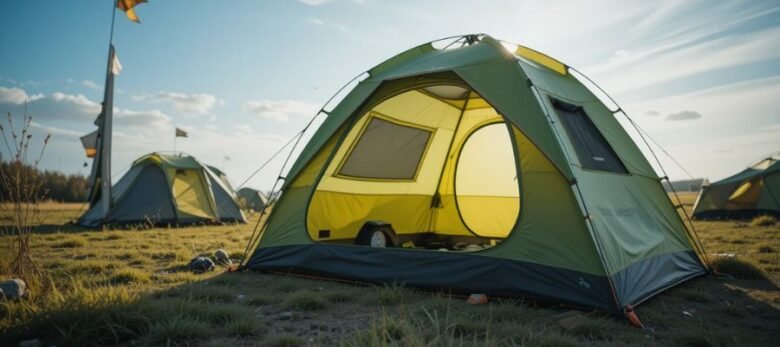Pop up tents are incredibly convenient for quick camping trips, festivals, or beach outings. However, their lightweight design can make them vulnerable to strong winds. To ensure your tent stays securely in place, follow these five practical tips to prevent it from blowing away.
1. Choose the Right Spot
The location where you pitch your tent plays a significant role in its stability.
- Look for Natural Windbreaks: Set up your tent near trees, bushes, or rocks to shield it from direct wind.
- Avoid Exposed Areas: Open fields or hilltops are prone to stronger winds. Opt for low-lying areas where the wind impact is reduced.
- Assess the Ground: Ensure the surface is flat and firm for better stake placement.
Pro Tip: Position the tent’s narrowest side facing the wind to minimize resistance.
2. Use Heavy-Duty Tent Stakes
Standard stakes that come with most pop up tents may not be sufficient for windy conditions. Upgrade to heavy-duty stakes for extra security.
- Recommended Stakes:
- Steel or Aluminum Stakes: Durable and less likely to bend.
- Spiral Stakes: Provide a better grip in soft soil or sand.
- How to Secure:
- Drive the stakes into the ground at a 45-degree angle, pointing away from the tent.
- Attach the tent loops or guy lines securely to the stakes.
Pro Tip: Carry extra stakes as backups in case the ground conditions require additional support.
3. Reinforce with Guy Lines
Guy lines are essential for stabilizing your tent during windy conditions.
- Steps to Use Guy Lines:
- Attach the guy lines to the designated loops on your tent.
- Extend the lines outward and secure them to the ground with stakes.
- Tighten the lines to ensure the tent is taut but not overly stretched.
- Benefits: Guy lines distribute wind pressure evenly across the tent, reducing the risk of collapse.
Pro Tip: Use reflective guy lines to prevent tripping over them at night.
4. Add Weight to Anchor the Tent
If the wind is particularly strong, adding weight to your tent can provide additional stability.
- Ways to Anchor Your Tent:
- Sandbags: Fill sandbags or DIY weight bags and place them at the tent’s corners.
- Backpacks or Gear: Use your camping gear to weigh down the tent inside.
- Rocks or Logs: Collect natural weights from the surrounding area and secure them around the base.
Pro Tip: Avoid overloading the tent’s structure with too much weight, as it may damage the material.
5. Check the Weather and Be Prepared
Preparation is key to preventing your tent from blowing away. Before your trip, check the weather forecast for wind conditions.
- Pre-Trip Checklist:
- Bring extra stakes, guy lines, and repair kits.
- Practice setting up and securing your tent in windy conditions at home.
- Familiarize yourself with your tent’s design to ensure quick adjustments if needed.
- During the Trip:
- If winds intensify, reinforce your tent’s setup by tightening guy lines or adding additional stakes and weights.
- Consider taking the tent down temporarily during extreme wind to avoid damage.
Bonus Tip: Choose a Wind-Resistant Pop Up Tent
Some pop up tents are designed specifically to handle windy conditions. Look for models with low profiles, sturdy materials, and reinforced poles.
Examples of Wind-Resistant Pop Up Tents:
- Quechua 2 Seconds Fresh & Black Tent
- Coleman FastPitch Galiano Tent
- Teton Sports Vista Quick Tent
Conclusion
Keeping your pop up tent secure in windy conditions doesn’t have to be a challenge. By choosing the right location, using heavy-duty stakes and guy lines, adding weight, and staying prepared, you can enjoy a safe and stress-free camping experience. With these tips, your tent will stay firmly in place, no matter what Mother Nature has in store.
Reviewed and updated on 01/24/2025




